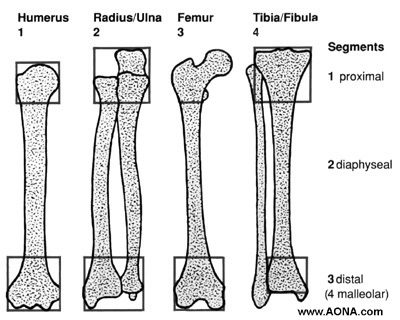
This is designated by two numbers, one for the bone and one for its segment. Click on the anatomic location in the image below for a detailed description of each bone and segment shown.

Each long bone has three segments: the proximal, the diaphyseal, and the distal segment (Fig. 2). The malleolar segment is an exception and is classified as the fourth segment of the tibia/fibula (44-).
The proximal and distal segments of long bones are defined by a square whose sides are the same length as the widest part of the epiphysis (exceptions: 31-, and 44-).
Before a fracture can be assigned to a segment, one must first determine its center. In a simple fracture the center of the fracture is obvious. In a wedge fracture the center is at the level of the broadest part of the wedge. In a complex fracture the center can only be determined after reduction. Any fracture associated with a displaced articular component is classified as an articular fracture. If the fracture is associated only with an undisplaced fissure which reaches the joint, it is classified as metaphyseal or diaphyseal depending on where its center is.